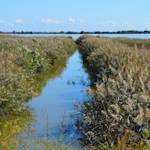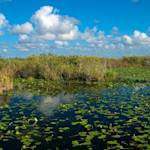The Great Vasyugan Mire (Bolshoye Vasyuganskoye)
2023 CE • Russia
Located in Russia, the Great Vasyugan Mire "is the largest mire not only in the Northern Hemisphere, but on the whole planet. The wetland, named after the river Vasyugan, a left tributary of the Ob, is situated in the middle and south of the West Siberian plain, in the taiga and forest-steppe zones. The Vasyugan Mires began to form after the recession of the glacier during the last Ice Age, about 10 thousand years ago. First, 19 primary isolated wetland areas formed in its flat hollows, which then gradually merged into one. Even now, the system is actively extending with continuous bogging processes along the periphery, which add about 800 hectares to its surface area every year . . . There are about 800 thousand lakes and ponds in the Vasyugan Mire" with over 20 rivers originating in the region. Due to its scale "and its input into the global deposition of atmospheric carbon, the wetland plays a major climatic role at the planetary scale . . . The Vasyugan Mire has retained its primeval richness of wetland and taiga fauna typical for Western Siberia." The swamp is home to an impressive array of wildlife from birds such as peregrine falcons and golden eagles to reindeer and moose. The ecoregion remained relatively untouched until the 1960s when it was drained for agriculture. Additionally, in the 1970s, oil and gas exploration was introduced into the mire, leading to pollution and development. Often referred to as the second "green lungs" of the world after the Amazon Rainforest for its ability to absorb carbon, the Great Vasyugan Mire holds global importance, and in 2017, the Vasyuganskiy Nature Reserve was created to protect it.
Quote: "Wetlands – the climate control system of the planet," Science First Hand 59, no. 3, December 27, 2021.
"VASYUGAN MARSHES," Facts and Details, last updated September 2020. SN Kirpotin, OA Antoshkina, AE Berezin, S Elshehawi, A Feurdean, ED Lapshina, OS Pokrovsky, AM Peregon, NM Semenova, F Tanneberger, IV Volkov, II Volkova, and H Joosten, "Great Vasyugan Mire: How the world's largest peatland helps addressing the world's largest problems," Ambio 50, no.11: (2021).
Image: Alaska DOT&PF, CC BY 2.0, via Wikimedia Commons


Learn about Maya Lin’s fifth and final memorial: a multi-platform science based artwork that presents an ecological history of our world - past, present, and future.

Discover ecological histories and stories of former abundance, loss, and recovery on the map of memory.

Learn how we can reduce our emissions and protect and restore species and habitats – around the world.

See how art can help us rethink the problems we face, and give us hope that each one of us can make a difference.

Help make a global memorial something personal and close to home. Share your stories of the natural world.


